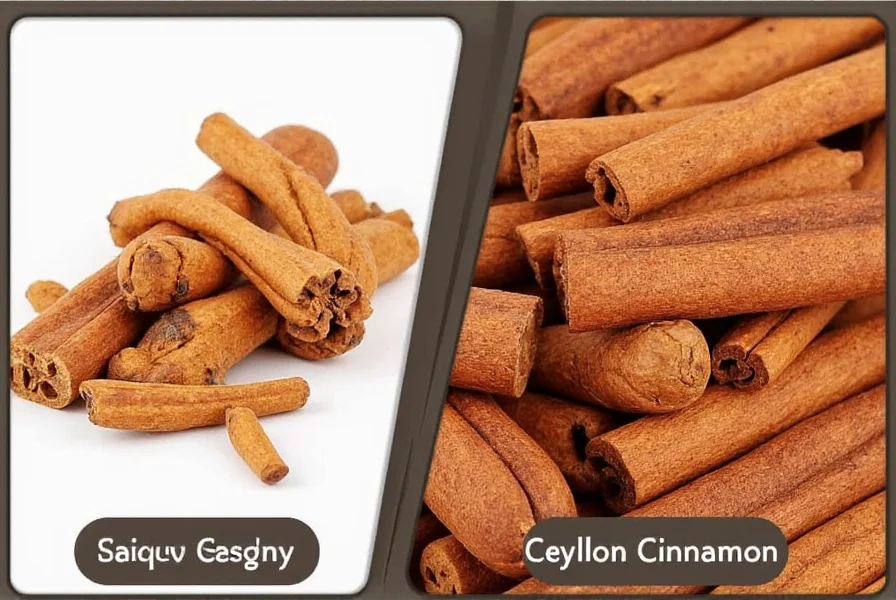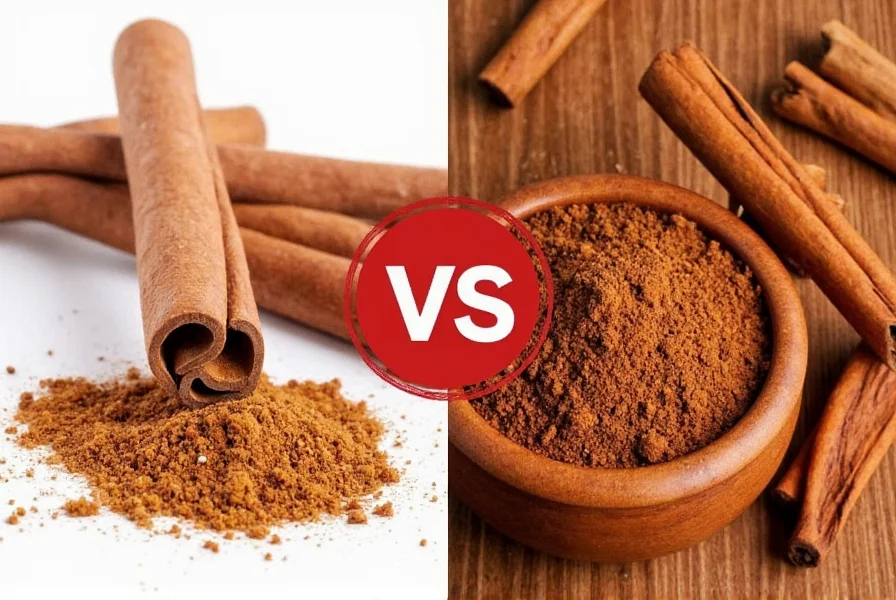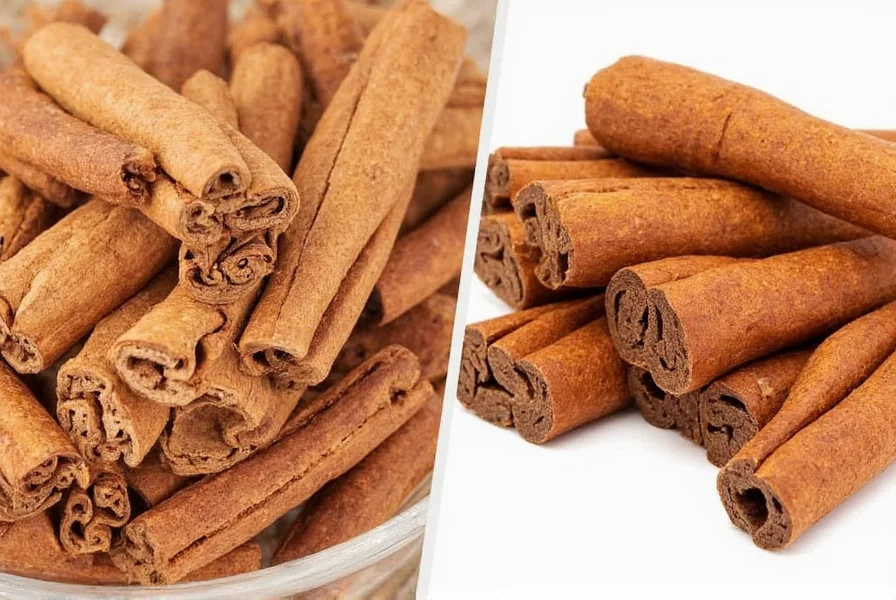Saigon cinnamon (Cinnamomum loureiroi) contains 50-100 times more coumarin than Ceylon cinnamon (Cinnamomum verum), making Ceylon the safer choice for regular consumption. Saigon offers a stronger, spicier flavor with higher essential oil content (1-3%), while Ceylon provides a delicate, sweeter taste with multiple thin bark layers. For health-conscious users seeking which cinnamon has less coumarin for daily use, Ceylon is significantly preferable due to its minimal coumarin levels (0.017g/kg versus Saigon's 6.97g/kg).
When comparing saigon cinnamon vs ceylon cinnamon, understanding their fundamental differences helps consumers make informed choices for both culinary and health purposes. These two popular cinnamon varieties often cause confusion in grocery stores and kitchens worldwide. This comprehensive comparison examines their botanical origins, chemical composition, flavor profiles, health implications, and practical applications to help you determine which cinnamon is better for specific cooking needs and regular consumption.
Botanical Origins and Production
Saigon cinnamon, also known as Vietnamese cinnamon, comes from the Cinnamomum loureiroi tree native to Vietnam's central regions. This variety belongs to the same species as Cassia cinnamon (Cinnamomum cassia) but contains even higher concentrations of essential oils and coumarin. Saigon cinnamon production centers around the Quang Ngai province, where specific soil conditions contribute to its intense flavor profile.
Ceylon cinnamon, often labeled "true cinnamon," originates from the Cinnamomum verum tree cultivated primarily in Sri Lanka (formerly Ceylon), with additional production in Madagascar and the Seychelles. This variety features a distinctive layered bark structure that peels into multiple thin sheets, creating its characteristic "quill" appearance. The harvesting process for Ceylon cinnamon requires skilled labor to carefully remove the delicate inner bark without damaging the tree.
Physical Characteristics Comparison
| Characteristic | Saigon Cinnamon | Ceylon Cinnamon |
|---|---|---|
| Bark Structure | Single thick, hard layer | Multiple thin, delicate layers |
| Color | Dark reddish-brown | Light tan to pale brown |
| Texture | Rough, difficult to crush | Soft, easily crumbled |
| Essential Oil Content | 1-3% (higher) | 0.5-1% (lower) |
| Coumarin Content | 2,500-6,970 mg/kg | 17-68 mg/kg |
Chemical Composition and Health Implications
The most critical difference between these cinnamon varieties involves coumarin content—a natural compound that can cause liver damage in high doses. Saigon cinnamon contains dangerously high coumarin levels (up to 6.97g/kg), while Ceylon cinnamon contains minimal amounts (approximately 0.017g/kg). This distinction makes Ceylon cinnamon the preferred choice for daily cinnamon consumption health benefits, particularly for children, pregnant women, and individuals with liver conditions.
Both varieties contain cinnamaldehyde, the compound responsible for cinnamon's characteristic flavor and aroma, but Saigon cinnamon has higher concentrations (25-30% versus Ceylon's 50-60% cinnamaldehyde). This explains Saigon's more intense, spicy heat compared to Ceylon's subtle sweetness. For those researching which cinnamon has more health benefits without risks, Ceylon provides similar antioxidant properties with significantly reduced health concerns.

Culinary Applications and Flavor Profiles
Chefs and home cooks select between these varieties based on specific recipe requirements. Saigon cinnamon's robust flavor makes it ideal for dishes requiring strong spice presence, such as:
- Spice-heavy baked goods (snickerdoodles, cinnamon rolls)
- Curries and savory Asian dishes
- Hot beverages where intense cinnamon flavor is desired
- Commercial food production where cost-effectiveness matters
Ceylon cinnamon's delicate flavor shines in applications where subtlety matters:
- Desserts requiring nuanced spice notes (custards, flans, delicate pastries)
- Mediterranean and Latin American dishes
- Breakfast cereals and yogurt where overpowering spice is undesirable
- Daily consumption in smoothies or health-focused recipes
Understanding when to use Saigon versus Ceylon cinnamon prevents flavor imbalances in recipes. Substitute Ceylon for Saigon at a 2:1 ratio (use twice as much Ceylon to achieve similar flavor intensity), but never substitute Saigon for Ceylon in recipes designed for delicate spice notes.
Identifying Authentic Products and Avoiding Adulteration
Consumers face challenges identifying genuine cinnamon varieties due to frequent mislabeling. Approximately 90% of "cinnamon" sold in the United States is actually Cassia or Saigon varieties marketed simply as "cinnamon." To ensure you're purchasing authentic Ceylon cinnamon:
- Examine the quill structure: Ceylon should have multiple thin, papery layers
- Check the color: Authentic Ceylon appears lighter (tan) compared to Saigon's dark reddish-brown
- Read ingredient labels carefully: Look for "Cinnamomum verum" or "Ceylon cinnamon"
- Purchase from reputable specialty spice merchants rather than generic grocery stores
Adulteration remains common in the spice industry, with some products containing fillers like cassia bark shavings or even toxic substances. For those concerned about how to tell the difference between real Ceylon and Saigon cinnamon, the layered structure and lighter color provide the most reliable visual indicators.
Storage Recommendations and Shelf Life
Both cinnamon varieties benefit from proper storage to maintain flavor and potency. Store ground cinnamon in airtight containers away from light and heat, where it retains optimal flavor for 6-12 months. Whole cinnamon sticks maintain freshness longer—up to 2-3 years when stored properly.
Saigon cinnamon's higher oil content makes it slightly more susceptible to rancidity compared to Ceylon. For long-term cinnamon storage tips, consider freezing whole sticks in vacuum-sealed bags for extended shelf life. Avoid storing cinnamon near strong-smelling spices, as it readily absorbs surrounding odors.

Practical Recommendations for Consumers
Based on extensive culinary testing and chemical analysis, here's when to choose each variety:
- Choose Ceylon cinnamon when: Consuming daily, preparing delicate desserts, cooking for children, or prioritizing health considerations
- Choose Saigon cinnamon when: Making bold-flavored baked goods, creating spice blends, or seeking cost-effective solutions for occasional use
For those investigating is Saigon cinnamon safe to eat regularly, moderation is key. The European Food Safety Authority recommends maximum daily coumarin intake of 0.1mg per kilogram of body weight. This means a 150-pound adult should limit Saigon cinnamon consumption to less than half a teaspoon daily, while Ceylon cinnamon allows for more generous usage.
Frequently Asked Questions
Which cinnamon has less coumarin for daily consumption?
Ceylon cinnamon contains significantly less coumarin (approximately 0.017g/kg) compared to Saigon cinnamon (up to 6.97g/kg). For daily consumption, Ceylon cinnamon is the safer choice, especially for children, pregnant women, and individuals with liver conditions.
Can I substitute Ceylon cinnamon for Saigon in recipes?
Yes, but use a 2:1 substitution ratio (twice as much Ceylon as Saigon) to achieve similar flavor intensity. Remember that Ceylon has a more delicate flavor profile, so it won't provide the same spicy heat as Saigon in recipes specifically designed for stronger cinnamon varieties.
How can I tell if I'm buying authentic Ceylon cinnamon?
Authentic Ceylon cinnamon has multiple thin, papery layers that form a soft, hollow quill, light tan color, and delicate texture that crumbles easily. Check labels for 'Cinnamomum verum' or 'Ceylon cinnamon' and purchase from reputable spice merchants rather than generic grocery stores where mislabeling is common.
Is Saigon cinnamon safe for regular consumption?
Saigon cinnamon contains high levels of coumarin which can cause liver damage with regular consumption. The European Food Safety Authority recommends limiting daily coumarin intake to 0.1mg per kilogram of body weight, meaning most adults should consume less than half a teaspoon of Saigon cinnamon daily. For regular use, Ceylon cinnamon is the safer option.
Which cinnamon variety offers better health benefits?
Both varieties contain beneficial antioxidants, but Ceylon cinnamon provides these benefits with significantly lower coumarin content. For regular consumption seeking health benefits without risks, Ceylon cinnamon is superior. Saigon cinnamon's higher coumarin levels outweigh its slightly higher antioxidant content for most health-conscious consumers.











 浙公网安备
33010002000092号
浙公网安备
33010002000092号 浙B2-20120091-4
浙B2-20120091-4